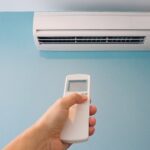1 The Main Sources of Air Pollution Today
Indoor air pollution is largely caused by human labor, production, and daily activities. Some of the main contributors include:
- Mold spores can form on walls, kitchen shelves, carpets, and clothes left unattended for long periods, especially in humid weather. Inhaling these spores can cause allergies and impact your family’s health.
- The use of charcoal and coal for cooking and heating produces carbon monoxide, which is harmful to human health. Burning incense excessively and regularly also leads to smoke accumulation in the house, allowing particulate matter to enter the lungs and causing serious health issues for your family.
- Door mats and floor carpets are breeding grounds for numerous bacteria. Additionally, some synthetic carpets may contain volatile organic compounds (VOCs) such as toluene, formaldehyde, and benzene, which are confirmed carcinogens by scientists.
- Using wall paint containing lead can severely affect your family’s health if exposed to it over an extended period.

- Cigarette smoke is a significant cause of indoor air pollution. Nicotine, a well-known carcinogen, is present in cigarette smoke.
- Excessive use of chemical cleaning agents, most of which contain volatile compounds like aerosol, can lead to respiratory issues.
- Paint and varnish on household items and furniture contain harmful components like industrial iron powder, hydrargyrum, and lead. Exposure to these substances increases the risk of asthma, especially in children.
- Many artificial air fresheners and scented candles contain ethylene glycol ether, which can cause neurological and blood-related problems.
- Burning candles made from paraffin wax releases benzene and toluene. Additionally, the chemicals used for coloring and scenting candles can be carcinogenic.
- Using cosmetics and personal care products like hair sprays and nail polishes can release VOCs into the indoor air, contributing to pollution.
- Pets, such as dogs, birds, cats, and reptiles, are also sources of indoor air pollution that are often overlooked. Regularly vaccinate and deworm your pets, and maintain good hygiene by bathing them periodically.

2 How to Know if Your Indoor Air is Polluted?
Signs of indoor air pollution include:
- Air pollutants may or may not have a noticeable smell. An unpleasant odor indicates a polluted area, but a pleasant fragrance doesn’t necessarily mean the air is clean.
- If you don’t have any eye problems but experience blurred vision, a filmy feeling in the eyes, tearing, or eye irritation, these could be signs that your body is reacting to poor air quality.
- Coughing, headaches, dizziness, and even feelings of depression and fatigue may indicate that your body is responding to polluted indoor air.
- If anyone in your family experiences skin problems, allergies, shortness of breath, acne, allergic rhinitis, sinusitis, or a runny nose, it’s a good idea to check the indoor air quality. You can do this by using an air quality monitor or taking preventive measures by thoroughly cleaning your living space.

3 Ways to Improve Indoor Air Quality
- Open windows regularly to let in fresh air and reduce the accumulation of pollutants inside your home.
- Create reasonable indoor green spaces to help purify and improve the air quality in your home.
- Use an essential oil diffuser with oils like eucalyptus, clove, and thyme to reduce indoor dust. Some oils, like tea tree oil, have antibacterial properties and can be added to homemade cleaning solutions or applied directly to the skin for minor cuts.
- It’s best to remove your shoes before entering the house to keep the air cleaner, regardless of the type of flooring you have.
- If you have pets, maintain their hygiene and groom them regularly. Consider investing in a robot vacuum cleaner that can sweep and mop the floors to ensure your home is free of pet hair and dander.
- Clean your house with environmentally friendly, organic cleaning products. For example, use natural essential oil-based cleaning products that also contain nano silver to disinfect and remove mold, or make your own floor cleaners with vinegar, baking soda, citrus juice, or essential oils.
- Use an air purifier to reduce harmful particles in the air, especially PM2.5, which can enter the lungs. This can significantly improve air quality and protect the health of your family.

4 Devices to Improve Indoor Air Quality
Air Purifiers
Air purifiers work on the principle of “suction and discharge,” emitting negative ions to neutralize harmful positive ions. The machine then pushes out clean air, creating a healthier living environment.

Air Conditioners with Air-Purifying Functions
In addition to temperature regulation, many air conditioners also have air-purifying capabilities to remove harmful substances like dust, allergens, bacteria, viruses, and unpleasant odors.
Some models can be equipped with special coatings to prevent dust and mold from accumulating on their components. They may also feature automatic cleaning functions to prevent the growth of mold and bacteria inside the unit, ensuring the air it releases is clean and healthy.

Air-Ionizing Fans
These fans cool, purify, deodorize, and disinfect the air while also balancing humidity levels. They are ideal for hot summer days and ensure a healthy, pleasant living environment for your family.








































